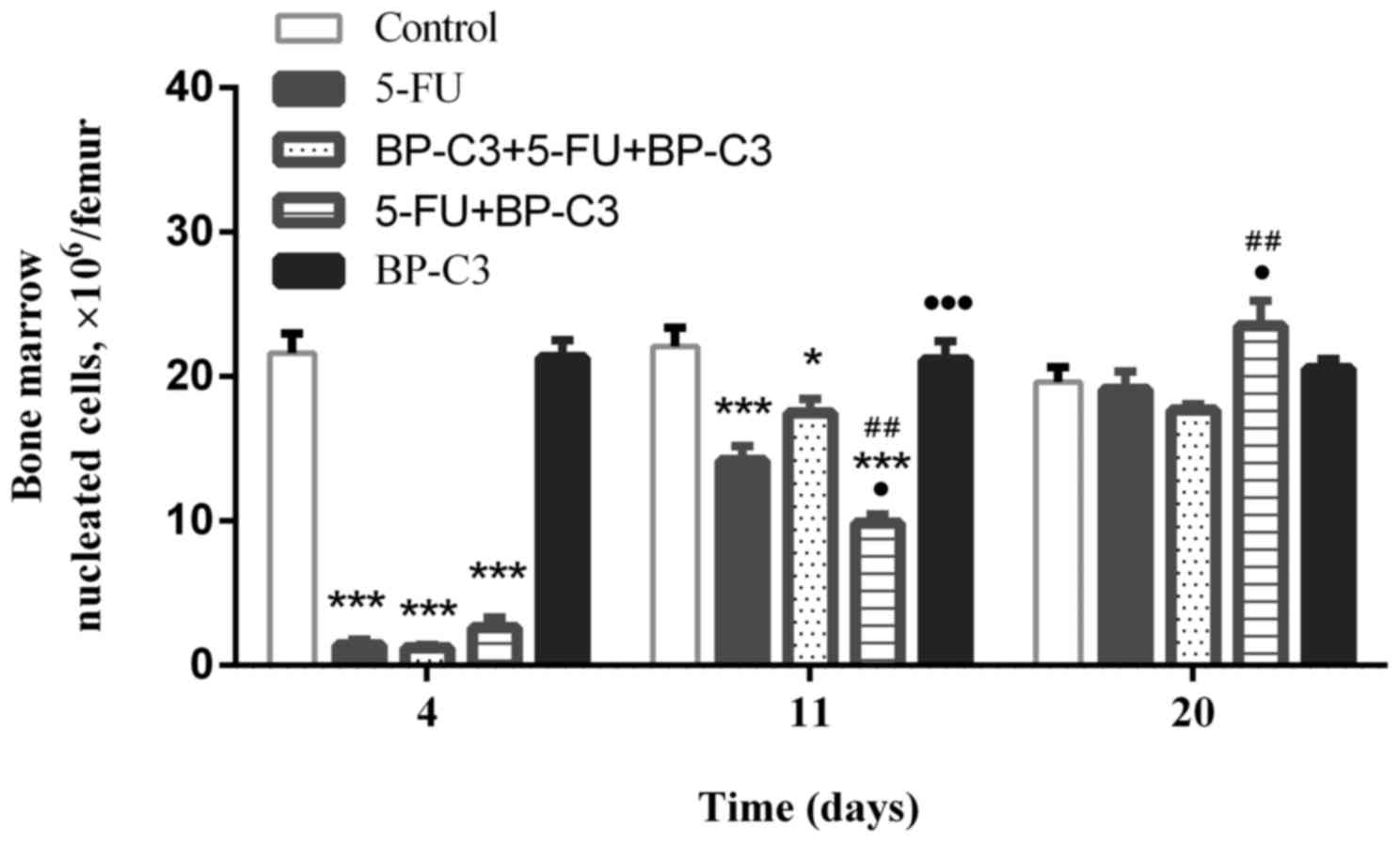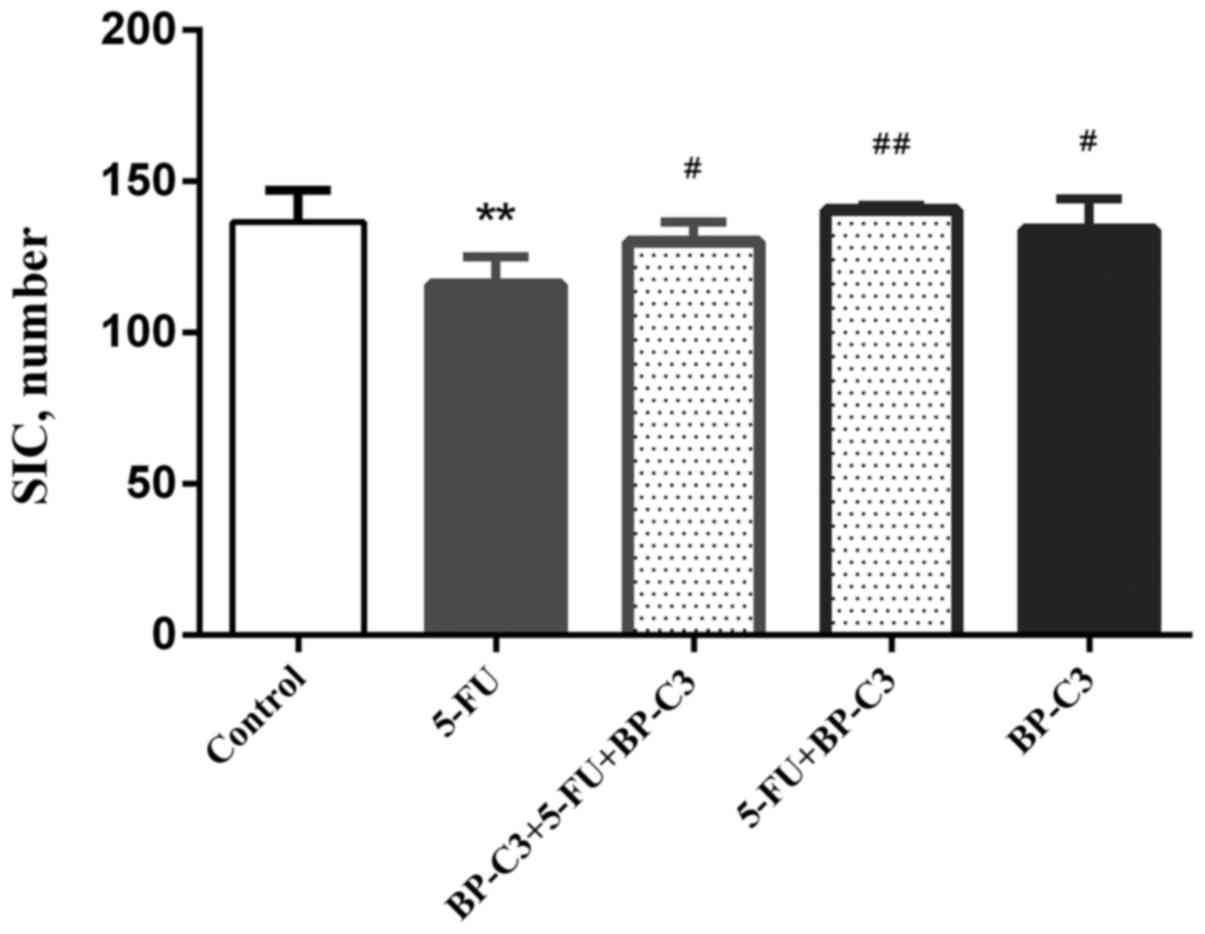|
1
|
Santi DV, McHenry CS and Sommer H:
Mechanism of interaction of thymidylate synthetase with
5-fluorodeoxyuridylate. Biochemistry. 13:471–481. 1974. View Article : Google Scholar : PubMed/NCBI
|
|
2
|
Nair KL, Jagadeeshan S, Nair SA and Kumar
GV: Biological evaluation of 5-fluorouracil nanoparticles for
cancer chemotherapy and its dependence on the carrier, PLGA. Int J
Nanomedicine. 6:1685–1697. 2011.PubMed/NCBI
|
|
3
|
Poon MA, O'Connell MJ, Moertel CG, Wieand
HS, Cullinan SA, Everson LK, Krook JE, Mailliard JA, Laurie JA,
Tschetter LK, et al: Biochemical modulation of fluorouracil:
Evidence of significant improvement of survival and quality of life
in patients with advanced colorectal carcinoma. J Clin Oncol.
7:1407–1418. 1989. View Article : Google Scholar : PubMed/NCBI
|
|
4
|
Matsunaga T, Tsuji Y, Kaai K, Kohno S,
Hirayama R, Alpers DH, Komoda T and Hara A: Toxicity against
gastric cancer cells by combined treatment with 5-fluorouracil and
mitomycin c: Implication in oxidative stress. Cancer Chemother
Pharmacol. 66:517–526. 2010. View Article : Google Scholar : PubMed/NCBI
|
|
5
|
Leitão RFC, Ribeiro RA, Bellaguarda EA,
Macedo FD, Silva LR, Oriá RB, Vale ML, Cunha FQ and Brito GA: Role
of nitric oxide on pathogenesis of 5-fluorouracil induced
experimental oral mucositis in hamster. Cancer Chemother Pharmacol.
59:603–612. 2007. View Article : Google Scholar : PubMed/NCBI
|
|
6
|
Braun MS and Seymour MT: Balancing the
efficacy and toxicity of chemotherapy in colorectal cancer. Ther
Adv Med Oncol. 3:43–52. 2011. View Article : Google Scholar : PubMed/NCBI
|
|
7
|
Ribeiro RA, Wanderley CW, Wong DV, Mota
JM, Leite CA, Souza MH, Cunha FQ and Lima-Júnior RC: Irinotecan-
and 5-fluorouracil-induced intestinal mucositis: Insights into
pathogenesis and therapeutic perspectives. Cancer Chemother
Pharmacol. 78:881–893. 2016. View Article : Google Scholar : PubMed/NCBI
|
|
8
|
You JS, Chen JP, Chan JS, Lee HF, Wong MK,
Yeung WF and Lao LX: Effect of YH0618 soup on chemotherapy-induced
toxicity in patients with cancer who have completed chemotherapy:
Study protocol for a randomized controlled trial. Trials.
17:3542016. View Article : Google Scholar : PubMed/NCBI
|
|
9
|
Coccia A, Mosca L, Puca R, Mangino G,
Rossi A and Lendaro E: Extra-virgin olive oil phenols block cell
cycle progression and modulate chemotherapeutic toxicity in bladder
cancer cells. Oncol Rep. 36:3095–3104. 2016. View Article : Google Scholar : PubMed/NCBI
|
|
10
|
Qazi SS, Li D, Briens C, Berruti F and
Abou-Zaid MM: Antioxidant activity of the lignins derived from
fluidized-bed fast pyrolysis. Molecules. 22:pii: E3722017.
View Article : Google Scholar
|
|
11
|
Shipov VP, Pigarev ES and Fedoros EI:
Benzene polycarboxylic acid compounds and their use as drug Patent
WO2013143549 A1. April 2–2013, issued October 3, 2013.
|
|
12
|
Larsen S, Butthongkomvong K, Manikhas A,
Trishkina E, Poddubuskaya E, Matrosova M, Srimuninnimit V and
Lindkær-Jensen S: BP-C1 in the treatment of patients with stage IV
breast cancer: A randomized, double-blind, placebo-controlled
multicenter study and an additional open-label treatment phase.
Breast Cancer (Dove Med Press). 6:179–189. 2014.PubMed/NCBI
|
|
13
|
Fares F, Fares B, Azzam N, Nashashibi M,
Nevelsky A, Larsen S and Lindkær-Jensen S: An innovative complex of
benzene-poly-carboxylic acid and molybdenum, for prevention and
treatment of radiation dermatitis. Med Chem. 5:447–451. 2015.
View Article : Google Scholar
|
|
14
|
Ibrahim T, Larsen S, Jensen NHL and
Lindkær-Jensen S: BP-C2 improves functional status, quality of life
and corrects biochemical imbalances as adjuvant therapy to
FOLFIRINOX treatment: A case of advanced inoperable pancreatic
cancer. J Clin Case Rep. 5:5142015.
|
|
15
|
Anisimov VN, Popovich IG, Zabezhinski MA,
Yurova MN, Tyndyk ML, Anikin IV, Egormin PA, Baldueva IA, Fedoros
EI, Pigarev SE and Panchenko AV: Polyphenolic drug composition
based on benzenepolycarboxylic acids (BP-C3) increases life span
and inhibits spontaneous tumorigenesis in female SHR mice. Aging
(Albany NY). 8:1866–1875. 2016. View Article : Google Scholar : PubMed/NCBI
|
|
16
|
Anisimov VN, Zabezhinski MA, Popovich IG,
Tyndyk ML, Anikin IV, Egormin PA, Yurova MN, Piskunova TS,
Panchenko AV, Shipov VP, et al N.N. Petrov Research Institute of
Oncology, Nobel Ltd., : Pharmacological geroprotective composition
and method of obtaining thereof Russian patent RU 2522547. 2014
|
|
17
|
Tian Y, Xiang Y, Wan G, Wan D, Zhu H, Wang
T and Yang X: Effects and mechanisms of Bazhen decoction, Siwu
decoction and Sijunzi decoction on 5-fluorouracil-induced anemia in
mice. J Tradit Chin Med. 36:486–495. 2016. View Article : Google Scholar : PubMed/NCBI
|
|
18
|
Vershinina SF and Stukov AN: Handbook of
experimental therapy of tumours. FGU RSCRST and FGU RIO n.a. NN
Petrov of the FAHTMC of Russian Federation, Reprint LLC,
Saint-Petersburg. pp. 252008, (In Russian).
|
|
19
|
Mcculloch EA and Till JE: The radiation
sensitivity of normal mouse bone marrow cells, determined by
quantitative marrow transplantation into irradiated mice. Radiat
Res. 13:115–125. 1960. View
Article : Google Scholar : PubMed/NCBI
|
|
20
|
Withers HR and Elkind MM: Microcolony
survival assay for cells of mouse intestinal mucosa exposed to
radiation. Int J Radiat Biol Relat Stud Phys Chem Med. 17:261–267.
1970. View Article : Google Scholar : PubMed/NCBI
|
|
21
|
Coronado-Cerda EE, Franco-Molina MA,
Mendoza-Gamboa E, Prado-García H, Rivera-Morales LG,
Zapata-Benavides P, Rodríguez-Salazar Mdel C, Caballero-Hernandez
D, Tamez-Guerra RS and Rodríguez-Padilla C: In vivo chemoprotective
activity of bovine dialyzable leukocyte extract in mouse bone
marrow cells against damage induced by 5-fluorouracil. J Immunol
Res. 2016:69423212016. View Article : Google Scholar : PubMed/NCBI
|
|
22
|
Sak K: Chemotherapy and dietary
phytochemical agents. Chemother Res Pract.
2012:2825702012.PubMed/NCBI
|
|
23
|
Katiyar SK, Mohan RR, Agarwal R and
Mukhtar H: Protection against induction of mouse skin papillomas
with low and high risk of conversion to malignancy by green tea
polyphenols. Carcinogenesis. 18:497–502. 1997. View Article : Google Scholar : PubMed/NCBI
|
|
24
|
Kubatka P, Kapinová A, Kello M, Kruzliak
P, Kajo K, Výbohová D, Mahmood S, Murin R, Viera T, Mojžiš J, et
al: Fruit peel polyphenols demonstrate substantial anti-tumour
effects in the model of breast cancer. Eur J Nutr. 55:955–965.
2016. View Article : Google Scholar : PubMed/NCBI
|
|
25
|
Mileo AM and Miccadei S: Polyphenols as
modulator of oxidative stress in cancer disease: New therapeutic
strategies. Oxid Med Cell Longev. 2016:64756242016. View Article : Google Scholar : PubMed/NCBI
|
|
26
|
Barrajón-Catalán E, Herranz-López M, Joven
J, Segura-Carretero A, Alonso-Villaverde C, Menéndez JA and Micol
V: Molecular promiscuity of plant polyphenols in the management of
age-related diseases: Far beyond their antioxidant properties. Adv
Exp Med Biol. 824:141–159. 2014. View Article : Google Scholar : PubMed/NCBI
|
|
27
|
Mut-Salud N, Álvarez PJ, Garrido JM,
Carrasco E, Aránega A and Rodríguez-Serrano F: Antioxidant intake
and antitumor therapy: Toward nutritional recommendations for
optimal results. Oxid Med Cell Longev. 2016:67195342016. View Article : Google Scholar : PubMed/NCBI
|
|
28
|
Lamson DW and Brignall MS: Antioxidants in
cancer therapy; their actions and interactions with oncologic
therapies. Altern Med Rev. 4:304–329. 1999.PubMed/NCBI
|
|
29
|
Lawenda BD, Kelly KM, Ladas EJ, Sagar SM,
Vickers A and Blumberg JB: Should supplemental antioxidant
administration be avoided during chemotherapy and radiation
therapy? J Natl Cancer Inst. 100:773–783. 2008. View Article : Google Scholar : PubMed/NCBI
|
|
30
|
Mileo AM and Miccadei S: Polyphenols as
modulator of oxidative stress in cancer disease: New therapeutic
strategies. Oxid Med Cell Longev. 2016:64756242016. View Article : Google Scholar : PubMed/NCBI
|
|
31
|
Gupte A and Mumper RJ: Elevated copper and
oxidative stress in cancer cells as a target for cancer treatment.
Cancer Treat Rev. 35:32–46. 2009. View Article : Google Scholar : PubMed/NCBI
|
|
32
|
Khan HY, Zubair H, Faisal M, Ullah MF,
Farhan M, Sarkar FH, Ahmad A and Hadi SM: Plant polyphenol induced
cell death in human cancer cells involves mobilization of
intracellular copper ions and reactive oxygen species generation: A
mechanism for cancer chemopreventive action. Mol Nutr Food Res.
58:437–446. 2014. View Article : Google Scholar : PubMed/NCBI
|
|
33
|
Kato S, Hayashi S, Kitahara Y, Nagasawa K,
Aono H, Shibata J, Utsumi D, Amagase K and Kadowaki M: Saireito
(TJ-114), a Japanese traditional herbal medicine, reduces
5-fluorouracil-induced intestinal mucositis in mice by inhibiting
cytokine-mediated apoptosis in intestinal crypt cells. PLoS One.
10:e01162132015. View Article : Google Scholar : PubMed/NCBI
|
|
34
|
Liska DJ: The detoxification enzyme
systems. Altern Med Rev. 3:187–198. 1998.PubMed/NCBI
|
|
35
|
Lee HJ, Kim JS, Moon C, Kim JC, Lee YS,
Jang JS, Jo SK and Kim SH: Modification of gamma-radiation response
in mice by green tea polyphenols. Phytother Res. 22:1380–1383.
2008. View
Article : Google Scholar : PubMed/NCBI
|
|
36
|
Wilken R, Veena MS, Wang MB and Srivatsan
ES: Curcumin: A review of anti-cancer properties and therapeutic
activity in head and neck squamous cell carcinoma. Mol Cancer.
10:122011. View Article : Google Scholar : PubMed/NCBI
|
|
37
|
Hejazi J, Rastmanesh R, Taleban FA, Molana
SH, Hejazi E, Ehtejab G and Hara N: Effect of curcumin
supplementation during radiotherapy on oxidative status of patients
with prostate cancer: A double blinded, randomized,
placebo-controlled study. Nutr Cancer. 68:77–85. 2016. View Article : Google Scholar : PubMed/NCBI
|












